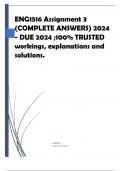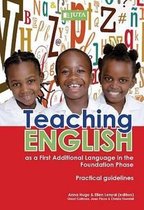ENG1516 Assignment 3
(COMPLETE ANSWERS) 2024
- DUE 2024 ;100% TRUSTED
workings, explanations and
solutions.
ADMIN
[COMPANY NAME]
, Question 1 1.1 In your own words, define rhyme. (2) 1.2 In your own words,
explain the difference between end rhyme and internal rhyme. (4) 1.3 Nursery
rhymes and poetry, according to Tut 501, are useful tools in assisting young
learners acquire basic language and mathematical skills. Write a short
paragraph in which you explain how this is achieved. (5) 1.4 Poems are made
up of several poetic elements such as the rhythm. In your own words, define
rhythm and explain how it is important when teaching poetry to Foundation
Phase learners. (4) [15]
1.1 Rhyme is a poetic device where words at the end of lines or within lines have similar sounds,
typically occurring at the end of a word.
1.2 End rhyme refers to the rhyming of words at the end of two or more lines of poetry, creating
a pattern and often marking the end of a stanza. Internal rhyme, on the other hand, involves
rhyming words within the same line or between multiple lines of poetry, adding emphasis and
musicality to the verse.
1.3 Nursery rhymes and poetry are invaluable tools for young learners as they provide engaging
and memorable ways to learn language and mathematical concepts. Through rhythmic repetition
and memorable melodies, nursery rhymes help children develop phonemic awareness,
vocabulary, and language comprehension skills. Additionally, many nursery rhymes incorporate
numerical concepts such as counting, sequencing, and basic arithmetic, making them effective
aids in early mathematical education.
1.4 Rhythm in poetry refers to the pattern of stressed and unstressed syllables within lines of
verse, creating a musical quality to the language. When teaching poetry to Foundation Phase
learners, rhythm is important as it helps children develop an ear for language and understand the
natural flow and cadence of words. By engaging with rhythmic patterns in poems, students can
improve their reading fluency, oral expression, and comprehension skills. Moreover, rhythmic
poems often have a playful and enjoyable quality, which can enhance students' enthusiasm for
poetry and language learning.
Question 2 2.1 Read through p. 102 of the Tutorial letter 501 and discuss the
importance of sense imagery when teaching poetry to children. (5) 2.2 Read
carefully the five different types of imageries on p. 102 of the Tutorial letter
501. Explain how each imagery is important when teaching poetry to
Foundation Phase learners. (3x5) [20]
Question 3 Read through the story and answer the questions that follow. The
Three Little Pigs Retold by Annie Flora Steel (1922), illustrated by L. Lesley
Brooke from the 1904 version. Downloaded by Corona Virus () lOMoARcPSD|





